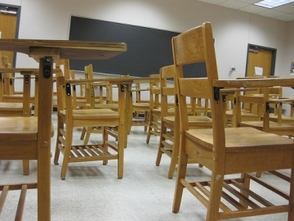 Credit: alamosbasement/Flickr
Credit: alamosbasement/Flickr - A student who receives an out-of-school suspension is almost two times as likely to drop out later.
- Suspended students miss out on important coursework and instructional time with teachers while at home, leaving them further behind their peers.
- Out-of-school suspensions create a negative school environment that disengages at-risk students from utilizing the school as a resource.
Practical public policy should aim to find solutions for fixing, not exacerbating, behavioral problems. Examples from urban public school districts, like Chicago and Cleveland, suggest that altering the school climate and moving away from punitive punishments like suspensions are better for increasing student and parent engagement, school safety, and reducing dropout rates.
Research in Chicago suggests that the safest school environments have strong relationships between parents, school teachers, and administrators — and, perhaps not surprisingly, low suspension rates; schools with high suspension rates did not improve feelings of safety, but eroded the level of trust between adults and students within the districts. Providing teachers and the administrators with the tools to use restorative practices — which focus on relationship-building and decision-making — has been shown to increase student engagement and bolster student-teacher relationships. Students also report that teachers are more respectful of them.
Cleveland Public Schools utilized tools from Conditions for Learning, an organization that works with urban schools to create safe classroom environments, and replaced out-of-school suspensions with in-school discipline measures in all elementary schools. One new measure is a social and emotional learning program called Promoting Alternative Thinking Strategies (PATHS), which helps students positively deal with their emotions and peacefully resolve conflicts with others. Conditions for Learning also developed student intervention support teams to address early warning signs of at-risk behavior, such as behavior citations or poor attendance. Addressing behavior with mediation, not punishment, translated to increased feelings of safety and support among students, according to the survey analysis.
Students who have taken part in behavioral programs instead of out-of-school suspension programs have produced measureable academic gains. Research suggests that using a comprehensive evaluation system within schools, like the U.S. Department of Education’s Positive Behavioral Intervention and Supports, has been shown to improve student behavior and social-emotional skills and increase overall student learning. When 28 participating schools followed the program over three years, they saw, in total, 6,010 fewer office discipline referrals and 1,032 fewer suspensions; simultaneously, these schools recovered 864 days of teaching, 1,701 days of learning for students, and 571 days of leadership. In this same study, the majority of schools that strictly followed the program saw academic gains in math for students.
Replacing out-of-school suspensions is no easy task, as it requires continual best-practice research and funding for rigorous programs that are staffed with high-quality educators. But these investments foster a more inclusive learning environment, perhaps making school meaningful to the students who need it the most.
Claire Bocage is a research assistant focusing on workplace psychology. Reach her via email.

 RSS Feed
RSS Feed